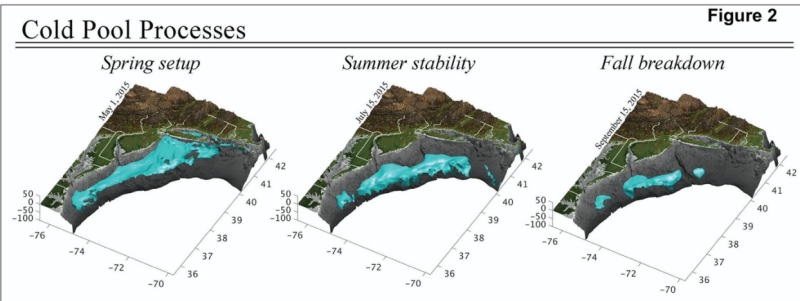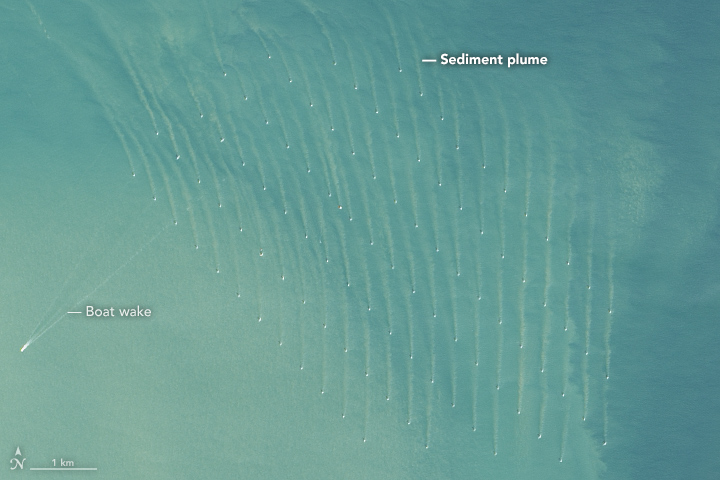Building arrays of offshore wind turbines off the mid-Atlantic states could have effects on the annual cycle of ocean water temperatures that are critical to the region’s fish and shellfish habitat, a new study suggests.
The paper from the Science Center for Marine Fisheries surveys years of research around northern European offshore wind installations, particularly in the North Sea. Travis Miles, Sarah Murphy, Josh Kohut, Sarah Bosetti, and Daphne Munroe, all of Rutgers University, reviewed existing literature on how three decades of wind farm construction has affected ocean environments in Europe.
The group looked at earlier findings about how the turbine structures may affect the local environment, including questions about how turbine foundations may interact with tidal currents, temperatures and sediments in the water column, and how the turbines’ extraction of energy from wind may affect the surface of the ocean around them.
Of particular interest is the so-called “cold pool,” the seasonal stratification of cooler water close to the bottom, peaking in summer and turning over in fall and spring. It’s important to the survival of key, commercially important species including scallops and surf clams, and is a driver of primary production and nutrients for the ocean food web.
Their findings “can’t tell you if there is significant impact, limited impact, or no impact” from installing turbine structures, cautioned Travis Miles, a physical oceanographer. “We were very good about saying what we know and don’t know.”
There are important differences in ocean conditions between the mid-Atlantic and North Sea, the paper notes. While North Sea tidal currents are faster and stronger, “in the mid-Atlantic we have much weaker tidal currents,” said Miles. “We are primarily a storm-driven continental shelf.”
Northeast gales and tropical systems can trigger big changes in stratification, mixing up the cold bottom and warmer waters close to the surface. Miles did his doctoral work at Rutgers on the impact of Hurricane Sandy in October 2012, when Miles and another graduate student deployed a Slocum electric glider autonomous vehicle to document how stratified temperature layers suddenly slid apart in the storm surge.
“We have one of the strongest top-to-bottom temperature differences in the world,” said Miles.
Stratification “is like a big blanket that holds the cold pool in place,” said Daphne Munroe, a biologist. That’s good for surf clams and scallops: “They live off New Jersey because they like cold water,” she said.
By mid-summer the cold pool is hard to displace, so in spring and fall “the timing of that buildup and breakdown is really important,” said Munroe.

According to the study, research in Europe has found some impact from wind power installations, including “turbines induce downstream impacts on ocean velocities, turbulence, and stratification.”
But many factors play into the extent of effects, differing from site to site and underlying ocean and wind conditions.
“These studies generally fall into three categories, including turbulence generated by turbine foundations; wind extraction reducing surface wind stress and altering water column turbulence; and wind farm wake driven divergence and convergence driving upwelling and downwelling,” the authors wrote. “All of these categories of impact could influence ocean mixing and in turn stratification that is a key characteristic of the mid-Atlantic Bight Cold Pool.”
“That’s the type of processes we’d like to look at,” said Miles.
“What’s planned to be installed here in the mid-Atlantic is much bigger than anything else in the world,” said Munroe. “There are modeling tools that can be used” to simulate what those effects could be, she said.
To answer those questions for the U.S. outer continental shelf, scientists will need to greatly expand on the European wind energy experience.
“The balance between potential reduction in ocean mixing due to wind extraction and increase in mixing due to the presence of offshore wind foundations must be assessed specific to what is known about our regional oceanography and relevant turbine specifications including foundation size and type and hub height and blade length,” the authors wrote.
“If these studies were to be performed, the net influence of the offshore wind facilities on ocean mixing could be assessed through the seasonal changes of the Cold Pool and considering both individual wind farm impacts and cumulative impacts across multiple offshore facilities. To consider the cumulative impacts, it is important to adapt analyses of offshore wind facilities in other coastal regions to the conditions specific to the mid-Atlantic Cold Pool.”




